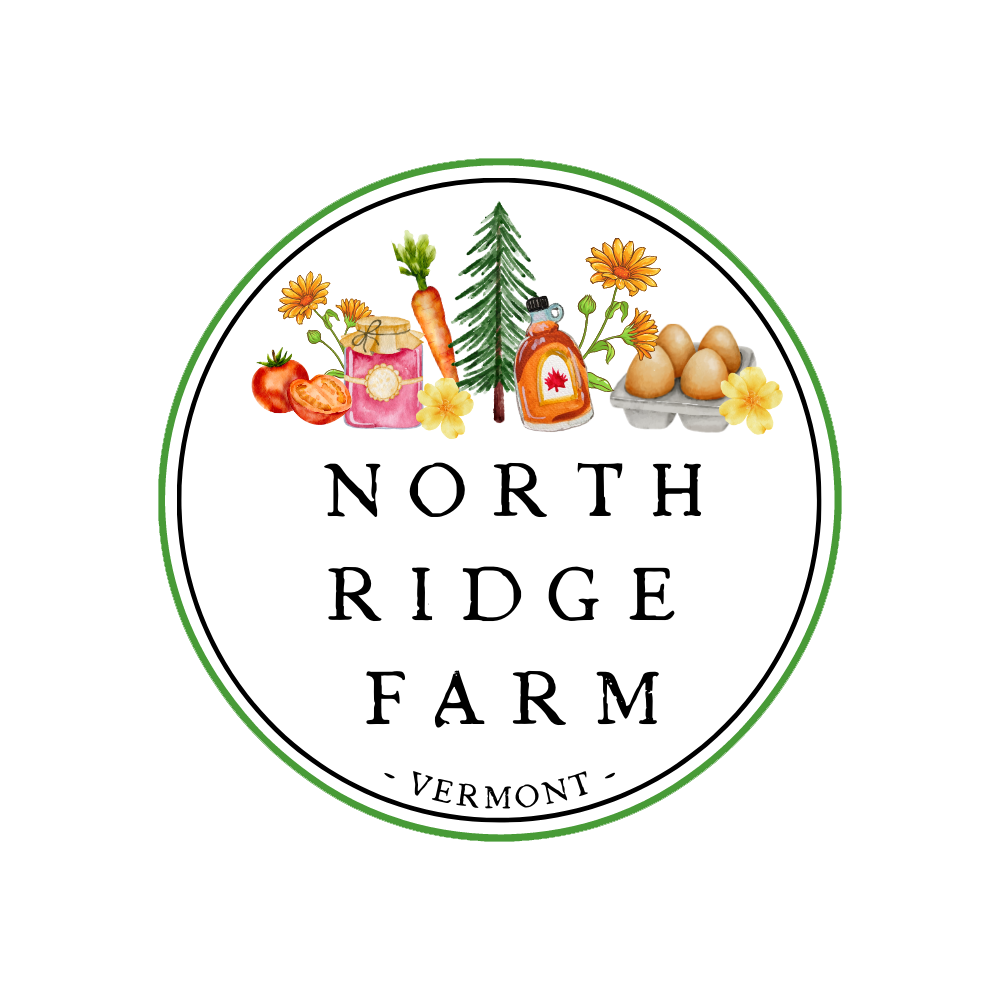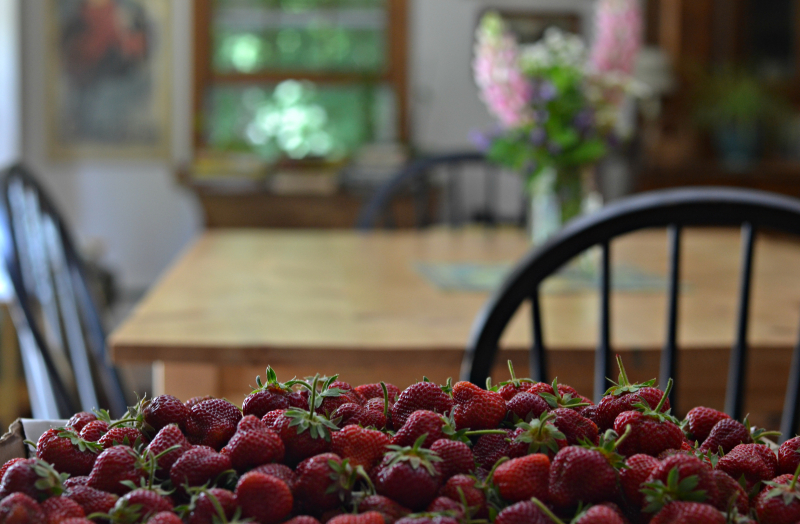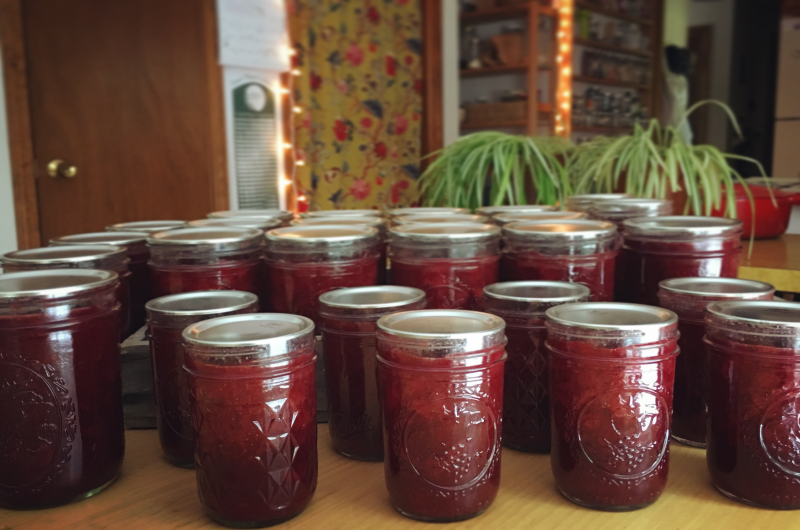It’s still June, so I’m still thinking and dreaming and talking about strawberries.
When I brought home all of those strawberries recently, it was a hot stretch of days and things were pretty busy in the garden, so I did what most of us do with the fast pace of summer fruit: I quickly cleaned it up and stuck it in the freezer to be dealt with another day.
Some years, that other day does not arrive until autumn, and even winter is a wise time for jam-making, but somehow I made time for it today. It was probably not the wisest decision, it is only 74º outside with cloud cover, and I’ve got a hundred things to do in the garden, but here I am, in the cool-ish kitchen with sticky jam on every imaginable surface and a canner humming away. As I wait for the timer to go off, and in between pulling pints of ruby red treasure from the pot, I thought I’d come here and share our basic strawberry jam recipe. I already have a strawberry jam recipe somewhere on this blog, but in recent years I’ve switched from using honey to maple sugar, which has a more neutral flavor (to us anyway).
For years I made jam because it felt like the thing to do, and it was tasty for sure, but the jars often lingered from one year to the next because as yummy as the jam was, we don’t actually eat much in the way of toast or sandwiches. On occasion, sure, but it felt like a chore to get through a jar before it turned moldy. Even smaller jars. I guess I’m slow with some things, because even though we don’t eat much toast, we do eat tons of yogurt. We make it plain, so a little window dressing goes a long way in terms of flavor and interest. Sometimes we have it with a drizzle of maple syrup and sprinkle of cinnamon, but whenever possible, we like our yogurt with some fruit. Prior to putting two and two together (yogurt + jam), we usually added frozen berries (hopefully after a few minutes to thaw), and called it good. And yes, nutritionally speaking, frozen fruit does come out ahead of canned fruit, but a couple of years ago I decided to let go of being hyper-vigilant about this sort of thing. Not to toss out reasonable information, but to make myself less crazy with food decisions day after day. Because as I’ve said before, in January, we want easy to eat sweet and tasty fruit, and we don’t buy much fruit out of season, so, frozen or canned it is. We keep both on hand, and when it’s three in the afternoon and I’m looking for a sweet bite (with a punch of protein and fat) to carry me through, yogurt with a scoop of home-canned jam sure beats a Skittles bender.
As far as the quantity of fruit that I can, it’s a simple formula. I just think about how much we eat in a year, aim for that as a minimum goal, round up generously for gift giving, helping out with Emily’s pantry at school, and having some on reserve for the promise of a rainy day.
For instance, we eat about 30-50 quarts of applesauce per year, so I aim for 50-75 quarts. I usually get to 50 no problem, reaching 75 makes me feel all kinds of prepper-ish, but it rarely happens. As for other canned fruits (whole fruit or jam), our yogurt habit puts us at about 1-2 pints per week, so I figure if I’ve got a solid 100 pints of fruit (all types – strawberries, raspberries, peaches, blueberries, blackberries, spiced apples…), we’ve got our needs covered as well as some buffer. Sliced fruits I can in quarts, applesauce is in quarts, jams and butters are in pints or half pints. Sometimes I’ll use four ounce jars for specialty things that I want to use up in one meal, like our peach cardamom butter that I use as a glaze for pork, or pear ginger jam that is so good on a charcuterie board.
Gosh, that’s a lot of jam talk. Not sure if this sort of thing interests others, but this is where my head is at this time of year. What we eat, how much we need, how much we’d like to set aside for sharing, and how I’m going to produce, source, and store it all. Riveting stuff.
One final thought: I use Pomona’s Pectin, which allows me to use very little sugar (or honey, etc.). I’d like to someday play around with no-pectin recipes. Maybe next year.
Okay, let's get to the recipe for strawberry jam. Enjoy!
Strawberry Jam
Makes about 4-5 half pint jars. Multiply the recipe for larger quantities.
We make maple sugar so it is something we have one hand, regular sugar or honey may be substituted. When you purchase Pomona's pectin, the box includes info on using honey (or maple syrup).
- 5 cups crushed, hulled strawberries
- 4 tbsp lemon juice
- 1/2 – 1 1/4 cups maple sugar (start with less and add more if needed. You can sub regular sugar, maple syrup, or honey)
- 2 tsp vanilla extract
- 2 tsp Pomona’s pectin
- 2 tsp calcium water (this comes with the pectin)
Directions:
- In very hot water, wash and rinse canning jars. Do this right before ready to use so jars are still hot. Alternatively, you can place clean jars on a rimmed baking sheet and pop them in a 150º oven about ten minutes before you’re ready to fill them.
- Add lids and rings to a large pot and cover with water. Bring to a strong simmer but do not boil. Keep lids and rings in hot water as you prepare jam.
- In a large pot combine mashed strawberries, lemon juice, and calcium water. Bring to a boil. Stirring often to prevent fruit from sticking to the pan.
- Meanwhile, in a separate bowl, combine (lesser amount of) maple sugar and pectin. Mix well. A small whisk works does a nice job of this.
- Add sugar/pectin mixture to the boiling fruit. Continue to stir and boil for 2 minutes or so, until jam begins to thicken. Stir in vanilla. Taste. Add more sugar if needed. Skim off any foam that forms on the surface of jam.
- Jam thickens upon cooling, so to best test your jam's doneness, put a teaspoonful on a saucer and refrigerate for a few minutes. Check for “jam” consistency. Cook another minute or so if not thick enough.
- Using a wide mouth funnel and small measuring cup as a scoop, fill hot/clean jars leaving 1/4" head space at the top. Wipe rim of jars with clean damp towel. Place lids on the top and screw on bands, not too tightly.
- Process jars in boiling water for 10 minutes. (Add one minute more for every 1,000 feet of elevation.) After the ten minutes, turn off heat, remove cover, and let jars sit in water for five minutes.
- Using a jar lifter, remove from water. Allow to sit in one spot and cool completely. Remove rings , wipe jars with a damp cloth to be sure they are clean, and add to your pantry!
____________________________________
Final thought: If you'd like to make a nice, thick strawberry syrup/sauce, go ahead and halve the pectin and calcium water and you'll achieve just that. Not that I'd know anything about it. And if I did, it would only be because I did it on purpose and not because I can't seem to multiply correctly when producing large batches. Either way, yum.


